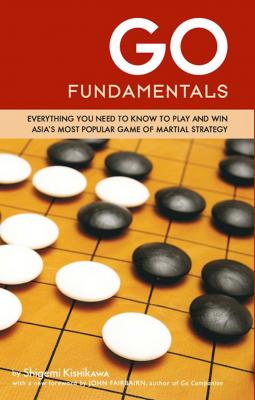ТОП просматриваемых книг сайта:
Go Fundamentals. Shigemi Kishikawa
Читать онлайн.Название Go Fundamentals
Год выпуска 0
isbn 9781462902620
Автор произведения Shigemi Kishikawa
Жанр Сделай Сам
Издательство Ingram
Published by Tuttle Publishing, an imprint of Periplus Editions (HK) Ltd., with editorial offices at 364 Innovation Drive, North Clarendon, Vermont 05759 U.S.A.
Copyright © 2009 Periplus Editions (HK) Ltd.
All rights reserved. No part of this publication may be reproduced or utilized in any form or by any means, electronic or mechanical, including photocopying, recording, or by any information storage and retrieval system, without prior written permission from the publisher.
Library of Congress Cataloging-in-Publication Data
Kishikawa, Shigemi.
Go fundamentals / by Shigemi Kishikawa.
p. cm.
ISBN 978-4-8053-1070-0 (pbk.)
1. Go (Game) I. Title.
GV1459.5.K56 2009
794’.4--dc22
2009013580
ISBN 978-1-4629-0262-0
Distributed by
North America, Latin America & Europe
Tuttle Publishing
364 Innovation Drive
North Clarendon, VT 05759-9436 U.S.A.
Tel: 1 (802) 773-8930; Fax: 1 (802) 773-6993
Japan
Tuttle Publishing
Yaekari Building, 3rd Floor
5-4-12 Osaki, Shinagawa-ku
Tokyo 141 0032
Tel: (81) 3 5437-0171; Fax: (81) 3 5437-0755
Asia Pacific
Berkeley Books Pte. Ltd.
61 Tai Seng Avenue #02-12
Singapore 534167
Tel: (65) 6280-1330; Fax: (65) 6280-6290
13 12 11 10 09 6 5 4 3 2 1
Printed in Singapore
TUTTLE PUBLISHING® is a registered trademark of Tuttle Publishing, a division of Periplus Editions (HK) Ltd.
Contents
Chapter 1 Equipment
Chapter 2 The Game
Chapter 3 Territory
Chapter 4 Connection and Disconnection
Chapter 5 Capture
Chapter 6 Life and Death
Chapter 7 Illegal Plays
Chapter 8 Seki Situation
Chapter 9 Ko Situation
Chapter 10 Basic Tactics
Chapter 11 Playing the Game
Foreword
The first substantive knowledge of the Chinese game of go in the in the western world dates from 1687, when the young Chinese scholar Shen Fuzong explained the game to Thomas Hyde at the Bodleian Library in Oxford, England. Shen, brought to Europe by a Jesuit missionary, had already been paraded at the Versailles court where the Sun King Louis requested a demonstration of chopsticks—but on gold plates, naturally.
Although Hyde was alert to the merits of the game and wrote about it, he clearly had only a fuzzy grasp of it, and go caught on in Europe no more than did chopsticks.
It was not until the self-imposed isolation of Japan was breached by Commodore Perry’s “black ships” in the mid 19th century and westerners began flocking there that its devotees learned enough to play an actual game and to teach others. Go had reached Japan from China over a thousand years before, and had been developed into its “national game.” A tiny handful of westerners even became tolerably proficient. The most notable was the chemist Oskar Korschelt, who studied at the school of the top player, Honinbo Shuho. He got to within a six-stone handicap of Shuho. On his return to Germany, Korschelt, who found “exceptional pleasure” in studying Shuho’s openings, shared his delight on the game with his 1884 work Das “Go”-Spiel. In itself, this was probably the single most important work that introduced the game to the west, but it had added importance in that it was heavily used by Arthur Smith for his Game of Go. This latter work had the advantage of being in English and published (by Tuttle, be it noted) in the large market of America.
Smith’s book was the one I learned from, also with exceptional pleasure. It is still a worthy book, but dated. It is not just that the references to players and openings are out of date, but that the rules are now a little different.
Despite all the merits of the Korschelt and Smith books, the plain fact was that in their heyday go was still a fringe activity in the west. There were a few clubs, but next to no materials for teaching beyond the beginner stage, and for most players just getting equipment to play on was a major problem. Many players of my generation, myself included, began by using makeshift boards with confectionary or drawing pins for the pieces.
The transition to the modern position of the game, where go is played widely outside the Far East, with a massive number of clubs and tournaments, well over 200 non-beginner books in English and a profusion of cheap equipment, did not begin until around 1960.
The first edition of this book, then called Stepping Stones to Go, was an important part of that movement.
Buoyed up by its people’s spectacular post-war economic recovery, the Japanese government began a concerted campaign of garnering goodwill overseas. Go was part of the drive. The go professionals’ organisation, the Nihon Ki-in, was encouraged to start a magazine in English, to send professionals abroad to teach, and to hold international tournaments for amateurs. Many Japanese amateurs such as Kishikawa

